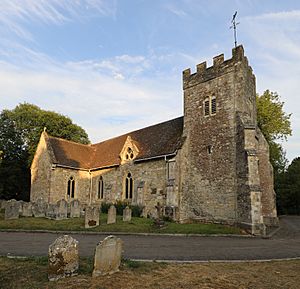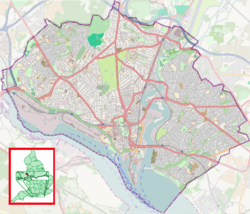St Mary's Church, South Stoneham facts for kids
Quick facts for kids St. Mary's Church, South Stoneham |
|
|---|---|
| Church of St. Mary | |

St Mary's Church, South Stoneham
|
|
| 50°56′12″N 1°22′31″W / 50.93656°N 1.37530°W | |
| Location | Swaythling, Hampshire |
| Country | England |
| Denomination | Anglican |
| Website | Parish of Swaythling |
| History | |
| Status | Parish church |
| Founded | 12th century |
| Dedication | St Mary |
| Architecture | |
| Functional status | Active |
| Heritage designation | Listed building - Grade I |
| Architectural type | Church |
| Style | Norman |
| Specifications | |
| Materials | Stone |
| Administration | |
| Parish | Swaythling |
| Deanery | Southampton |
| Archdeaconry | Bournemouth |
| Diocese | Winchester |
| Province | Canterbury |
St. Mary's Church in South Stoneham is a very old church in Southampton, England. It's one of only two medieval churches left in the city! Some parts of the church are from the Norman times, like the arch in the main part of the church, which is about 800 years old. You can find this special church tucked away near Southampton University.
Contents
A Look Back in Time: The Church's History
The South Stoneham Area
The area around St. Mary's Church, called South Stoneham, used to be huge! It covered over 8,000 acres (about 32 square kilometers). This large area stretched along the River Itchen, from where Eastleigh is today, all the way down to near Southampton. It also included places like Swaythling and Portswood.
Even though the church was there, there wasn't really a village called "South Stoneham." The church was just a few houses away from what is now part of Swaythling, a suburb of Southampton.
In a very old book called the Domesday Book, which was written in 1086, St. Mary's Church was mentioned. It belonged to a clerk named Richer. He also owned two other churches near Southampton.
By the 1500s, St. Mary's Church was connected to St. Mary's Church, Southampton. Both churches were under the special care of the Bishop of Winchester. Later, the main priest of St. Mary's, Southampton, got to choose who would be the priest at South Stoneham.
As Southampton grew bigger, a law in 1894 changed the boundaries. Much of the original South Stoneham area became part of new local areas. The remaining part, about 1,300 acres (5.3 square kilometers), included the church and Swaythling village.
Today, St. Mary's Church is part of the larger Swaythling area. The main church for this area is now St. Alban's Church, Southampton, which was built in 1933. The current vicar, who looks after both churches, is the Revd Peter Dockree.
The Church Building Over the Years
We know that parts of St. Mary's Church are very old, going back to the Norman period. The oldest part still standing is the chancel, which is the area around the altar. The arch leading into the chancel is from the 12th century, meaning it's over 800 years old! The large window at the east end of the chancel was added in the 1400s.
The main part of the church, called the nave, was built in the 1200s. The tall tower at the west end of the church was added later, in the late 1400s.
In 1728, the north transept (a part of the church that sticks out like an arm) was rebuilt. It was made to hold a beautiful monument for Edmund Dummer. Some people think a famous architect named Nicholas Hawksmoor designed this monument. The Dummer family were important people in Swaythling.
The south transept was built in 1854 during a big renovation. At that time, a new gallery was also added inside the church.
Exploring the Church Exterior
The church is made of stone with a tiled roof. It has a chancel, a nave, two side aisles, two small transepts, and a tower at the west end. The tower, built in the late 1400s, has small windows for the bells. It also has a special top part added later.
Above a window on the south side of the tower, there's a sundial from 1738. It has a message that says: "So Flies Life Away." Inside the tower are three bells. They were made in 1880, but some say two of them are even older, from the early 1600s! Above the main entrance on the west side, there's a small space that was probably meant for a statue of the Virgin Mary.
The churchyard has many old gravestones from the 1700s and 1800s. You can see carvings of angels, skulls, crowns, and hourglasses on them. The wall around the north side of the churchyard is also very old and is a protected building. It's an early 18th-century brick wall, about 8 feet (2.4 meters) high.
Notable Burials
Some important people are buried in the churchyard, including:
- Henry Bromfield, who was a Member of Parliament for Lymington. He was buried here in 1683.
Inside the Church
The church has a chancel and a nave, with smaller north and larger south transepts. The chancel is about 24 feet (7.3 meters) long and 15 feet 6 inches (4.7 meters) wide. The nave is about 52 feet 4 inches (15.9 meters) long and 20 feet 4 inches (6.2 meters) wide. The chancel arch and some of the walls in the nave are from the 12th century.
The large east window in the chancel is from the 1400s. It has three special shaped lights. On the north wall, there are three single windows. The middle one is higher and round-headed, from the 12th century. The two pointed windows next to it were added in the 1200s.
The chancel arch is very detailed, with two pointed sections. It has special columns with carved tops.
The nave has two windows on the north side and one on the south. It also has a gallery at the west end. The north transept has modern windows and opens to the nave with an arch that looks like it's from the 12th century. The south transept also opens to the nave with a tall arch that imitates 12th-century style.
The gallery holds a small organ built in 1857. There's also a very rare "dumb organist" from the same time. This device could play hymn tunes by turning a handle!
The Font
The font, which is used for baptisms, is at the north-east side of the nave. It's made of Purbeck marble and dates back to around 1180. The top part of the font is square and has four round arches carved into each side. The font sits on a central column and four smaller columns.
Monuments and Memorials
Above the chancel arch, you can see the royal coat of arms of King Charles II, dated 1660. On the south side of the chancel is the tomb of Edmund Clerke, who worked for the King. He died in 1632. His tomb shows him and his wife kneeling, along with their four sons and eight daughters.
The north wall of the north transept is covered by a large marble monument for Edmund Dummer (1663–1724). Several members of the Dummer family are buried here. Their family crypt (an underground burial vault) was beneath the church. However, it often flooded from the nearby River Itchen. In the 1960s, the church decided to fill in the crypt to solve this problem.
Other Special Items
St. Mary's Church has some of the most beautiful silver items in Southampton. The oldest silver cup is from 1630. The church also has a Bible from 1572 and a shepherd's crook that is said to be over 300 years old.
The church is also home to the University of Southampton's portable campanile. This is a set of 12 bells that were made in 1999.
Restoring the Church
In October 2008, the church announced plans for a big restoration project. It was expected to cost about £150,000. The vicar at the time, Rev. Gary Philbrick, said that the church is "a little gem" and "one of Southampton’s best kept secrets." He explained that the work was needed to fix problems from a previous restoration about 100 years ago.
Victorian builders had used cement-based mortar to repair the medieval stonework. This caused the stone to crack and let in dampness. The plan was to replace it with a special lime-based mortar.
The restoration work started with the west tower, the roof, and the damaged stonework. Once the old building dried out, which could take up to two years, the inside of the church would be redecorated.
The important work included:
- Replacing the cement mortar in the tower with lime mortar to stop dampness and protect the stone.
- Replacing lead flashings on the roofs to prevent water from getting in. This also involved fixing tiles, down-pipes, and gutters.
- Repairing the stonework, especially around the old Norman West Door and some windows.
- Moving the boiler from an old boiler house to the Clergy Vestry.
- Redecorating the inside of the church.
The restoration work was done by HGP Architects, with Michael Underwood as the main architect. He was an expert in conservation.
See also
- Listed buildings in Southampton



